Best Portugal Travel Guide – 27 must-visit places
I have wanted to explore Portugal since I was a kid and grew up with Portuguese friends. Through them, I experienced the warmth and culture of Portugal and I promised myself that one day I would spend some time exploring Portugal.
Condé Nast has recently announced that Portugal got first place as the best country in the world in the prestigious Readers’ Choice Awards 2022. According to My Dolce Casa’s study (they study online trends), Portugal got first place as the favourite destination to move or retire for North Americans.

I believe that the best way to discover what to see in a new place is to read personal experiences and what better way than to check in with travel writers about their favourite attractions in Portugal? There are many tourist attractions in Portugal from medieval villages to gorgeous beach towns, and fabulous food served in cafes and restaurants where you can just relax and while away the hours.
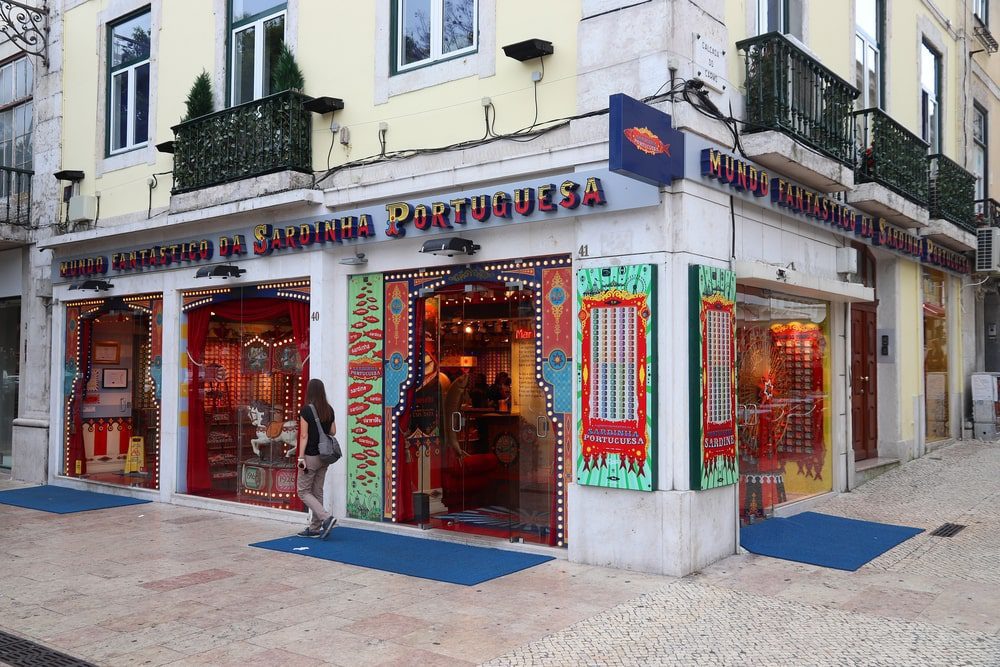
In the larger cities and tourist areas such as the Algarve, many in Portugal speak English and are incredibly welcoming to visitors. The larger cities have excellent public transportation but you may wish to rent a car to enable you to visit the more remote sites you want to see.
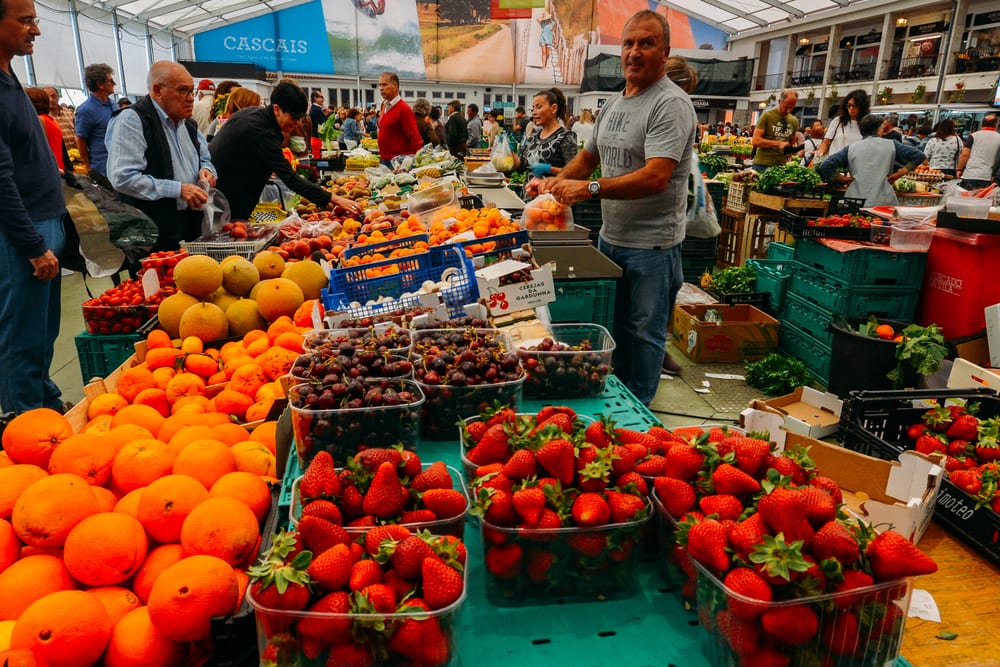
How to get to Portugal
Digital nomads have also been arriving in Portugal as the country offers a digital nomad visa. For those looking for a great European experience, Portugal has it all, and it is affordable. There are three international airports, in Lisbon, Porto, and Faro.
You can fly directly from London Stansted Airport (STN) to Porto Airport (OPO) on Ryanair several times a day. Alternatively, there are non-stop flights from London Luton Airport (LTN) and Gatwick Airport (LGW) to Lisbon or Porto. From Heathrow Airport you can fly directly to Lisbon or Porto too.
Which airlines offer direct flights to Portugal? From the USA TAP Air Portugal, Air Canada, United, Lufthansa, Brussels Airlines, SATA, Delta and KLM all fly non-stop to Portugal.
How many airlines fly non-stop from Toronto (YYZ) to Lisbon (LIS)? Three airlines. Air Canada, TAP Portugal and Air Transat have non-stop flights to Lisbon.
Xyuandbeyond is reader-supported. When you buy through links on our site, we may earn an affiliate commission. You can read my privacy policy here.
Your Portugal travel guide 27 places to put on your Portugal itinerary and bucket list
Pena Palace and Park
Visit the wonderfully whimsical, fairytale-esque Pena Palace and Park! Pena Palace is located near Lisbon in the historic town of Sintra. The brightly coloured Palace sits up high in the Sintra hills surrounded by Pena Park. The Park consists of a forest and lush exotic gardens with other 500 different species of trees originating from around the globe.
As a designated UNESCO World Heritage site and one of the Seven Wonders of Portugal, this is a must-see landmark. It’s unlike anything you’ve ever seen before. The uniqueness and fusion of so many different architectural styles from Neo-Gothic to New-Manueline to New-Islamic to Neo-Renaissance.
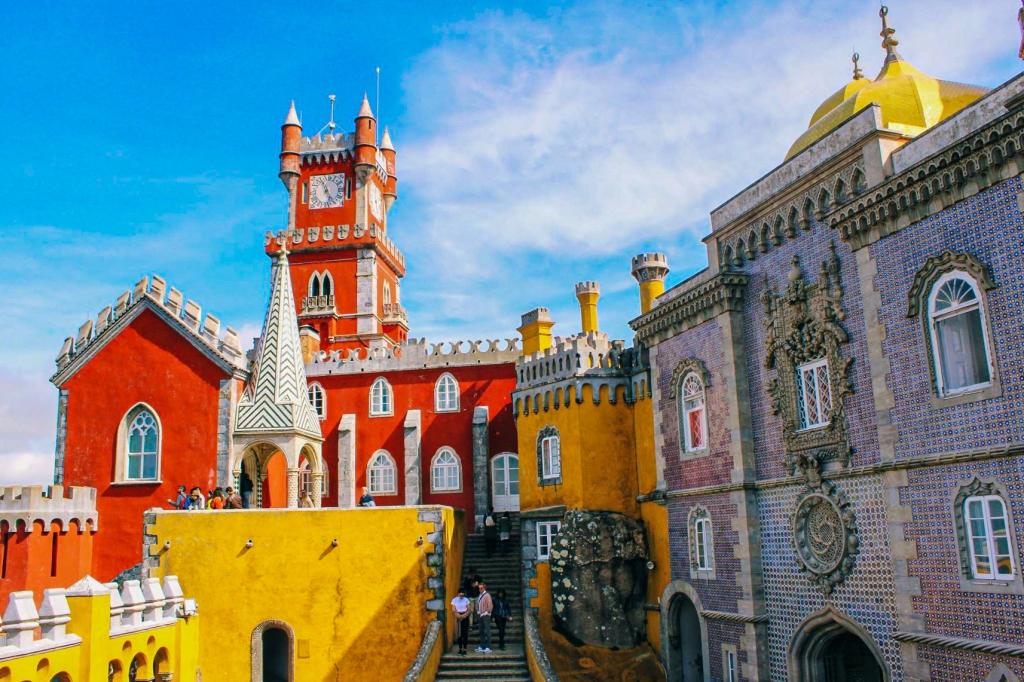
As one of the most visited attractions in all of Portugal, the best time to visit is early morning or late afternoon to avoid the crowds.
While touring Pena Palace and Park, take advantage of other interesting castles in the nearby hills of Sintra. A great one to visit is Moorish Castle for its scenic views and hiking trails. Experienced by Renee of Dream Plan Experience.
Ponta de Piedade
With its dramatic amber-tinged cliffs rising out of turquoise blue seas, Ponta de Piedade is possibly the finest example of the iconic Algarve coastline that southern Portugal is so famous for.
Carved out by the rain, wind, and waves into dramatic limestone arches, grottos and pillars, the cliffs are best admired from the sea. Join a kayak or paddle board tour or catch one of the many small boats that leave from a jetty at the bottom of a long flight of stairs down the cliff face.
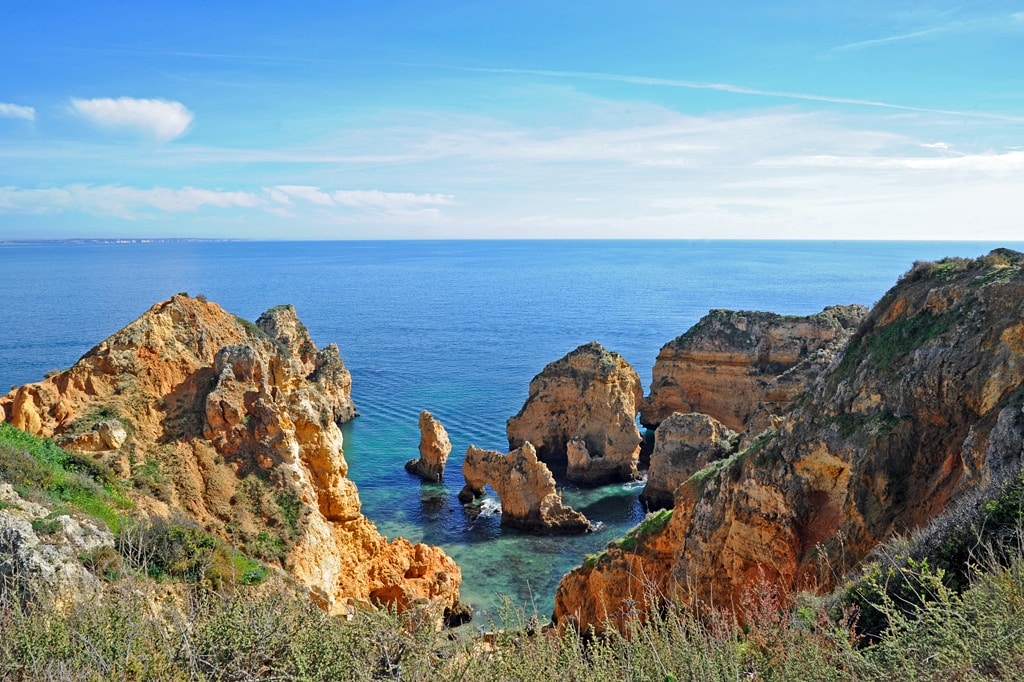
The views from the clifftops and the coastal tracks are spectacular too but be sure to stay on the paths and not venture too close to the cliff tops, especially out of season when landslides can occur. Being a headland jutting out to sea, sunrise and sunset are fabulous times to visit. It’s simply breathtaking.
There is a car park and a café but both get very busy. I’d recommend heading to Lagos for a bite to eat.
In the summer there’s a tourist road train that will take you to and from Lagos about 3km away. Otherwise, you can take a taxi or walk along a coastal path and enjoy the stunning views. Contributed by Kat of Travels with Kat.
Parque Nacional da Peneda-Gerês
Parque Nacional da Peneda-Gerês, Portugal’s only designated national park. Between the Peneda, Soajo, Amarela and Gerês mountains you can explore rivers and streams, and beautiful waterfalls and enjoy the sublime natural landscapes of Gerês, on several waking hikes. You will find historic sites, with dolmens and dolmens, medieval castles, monasteries and sanctuaries.
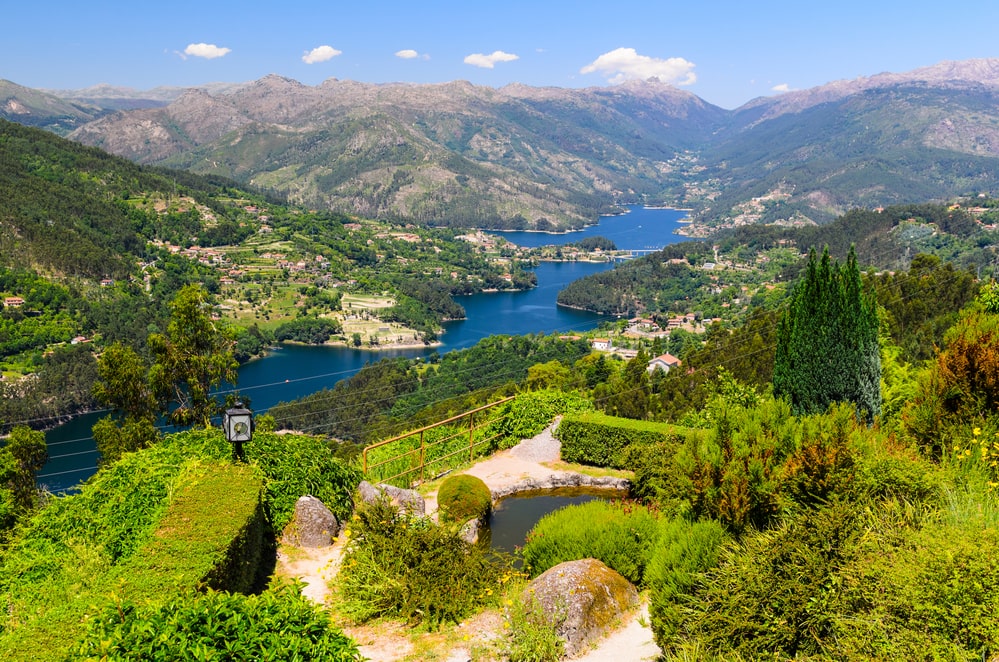
Serra da Estrela
Portugal’s main attractions are along its lengthy coast, making few people venture further inland. When exploring Portugal in depth, make sure to put the highest peak of Portugal’s mainland on your itinerary: Serra da Estrela. And the best part? You can simply drive or hitchhike to the top without breaking a sweat.
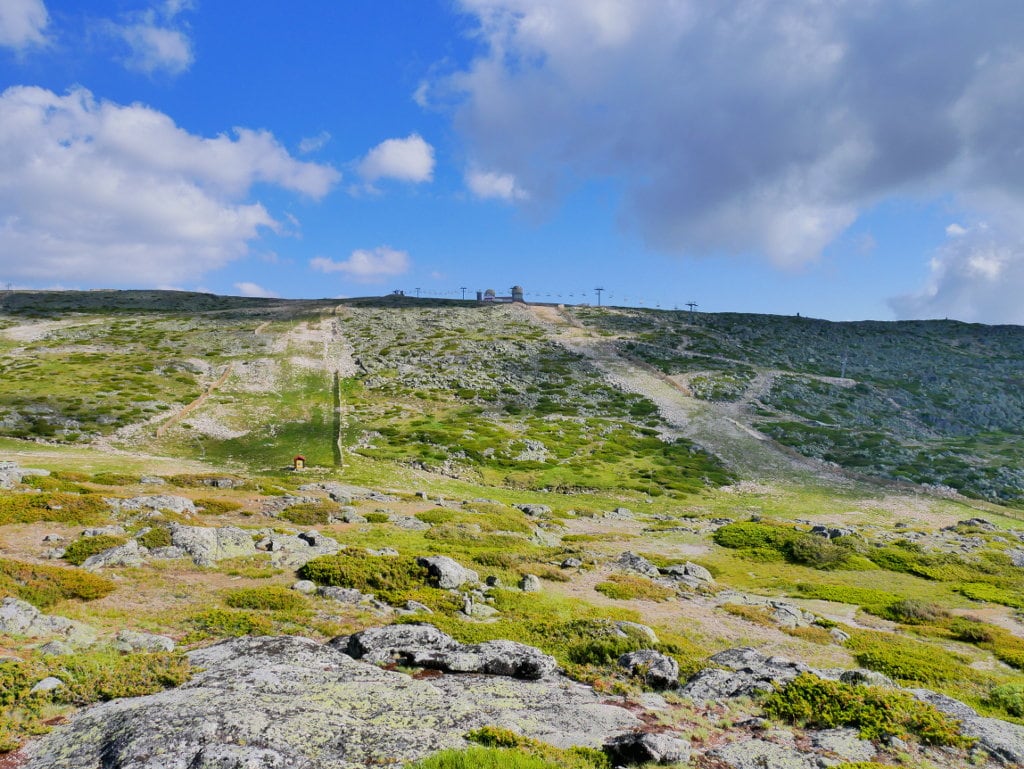
I love the ‘Star Mountain Range’ because it’s a unique cultural and natural area in Portugal. Inhabited since neolithic times, the people from this area have always lived a pastoral lifestyle until recently. This area is also where Portugal’s oldest cheese recipe comes from: queijo Serra da Estrela made with sheep milk. To make the picture complete, there’s also a local breed called Estrela Mountain Dog, a fluffy herding dog to protect the sheep. If you’re lucky, you’ll see some puppies.
Besides dog spotting and eating cheese at Restaurante a Torre, the area is pleasant for hiking in summer. There are several alpine lakes and dams in the area with streams leading down to pretty villages in the valleys. In winter, it’s possible to ski in the area at the peak with its broken radar domes. Even in summer, there are still patches of stubborn snow slowly melting away in the sun. Contributed by Iris from Mind of a Hitchhiker.
Cabo Da Roca
Portugal was once a great power of maritime accomplishment, and the country has a rich and glorious history of conquering the world during colonial times. Part of the reason was that Portugal was located at the west end of the Europe continent, and Cabo da Roca is a unique and special location to visit while you are on a day trip to Sintra.
Cabo da Roca is the westernmost point of continental Europe and the best time to visit there is during sunset. Watching the sun goes down the horizon will give you the energy to calm your mind and reset.
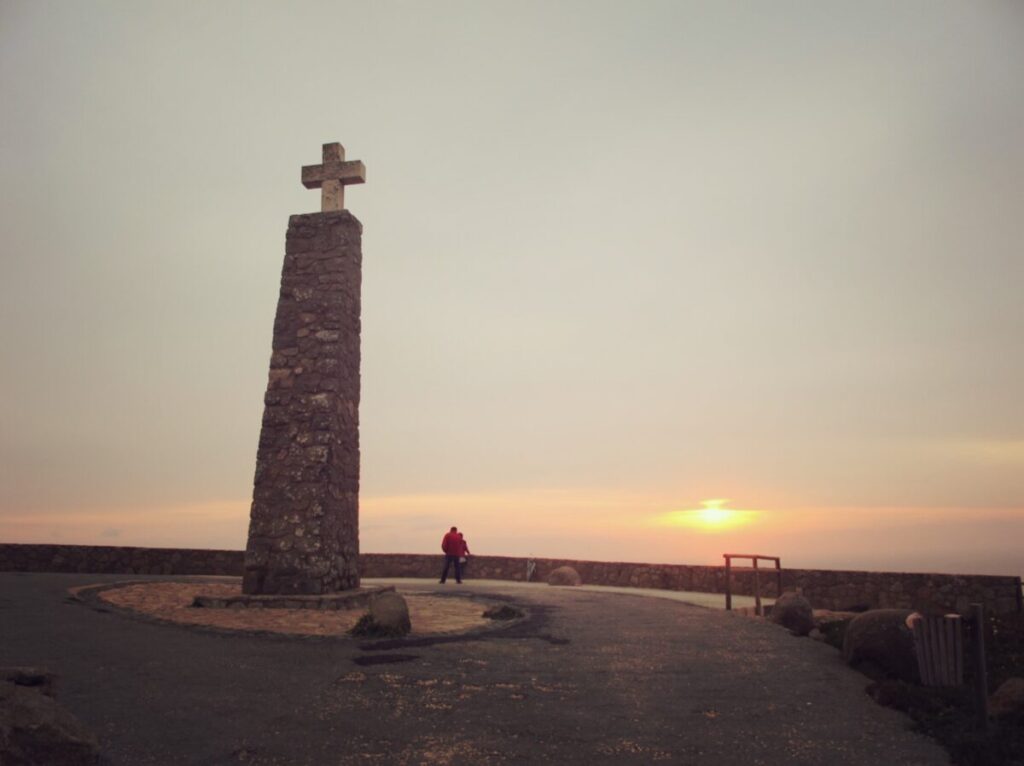
The best way to get there is by bus from Sintra or self-driving. Start the day walking leisurely on one of the many hiking trails in Nature Park: explore the deep valleys, visit intimate farms, or simply observe the unique flora and fauna. Enjoy a refreshment or an afternoon tea in one of the exotic resorts on the South Coast. Finally, head to Cabo da Roca in the evening, it is one of the best spots in Europe to view the sunset because it offers an unobstructed, panoramic view of the Atlantic Ocean.
The cape is a small open area with a lighthouse and a monument that says “Aqui, onde a terra se acaba e o mar começa…” (Where the land ends and the sea begins). This is a unique location and the poetic inscriptions hold dear to many visitors’ hearts. Contributed by Kenny of Knycx Journeying.
Lagos
Lagos in Portugal’s southern region, the Algarve, is a must-visit. There are so many things to do in Lagos, from exploring the old town, its slave trading history, and the town’s importance during the era of Discovery in Portugal. Lagos also boasts some of the most spectacular beaches in Portugal with fiery rock formations both on the beach and in the water.
Among the most impressive are Dona Ana Beach, Camilo Beach, and Praia dos Estudantes. The top attraction in Lagos, however, is Ponta da Piedade – a cluster of rock formations, natural arches, and caves raising up to 20 meters from the glittering ocean.
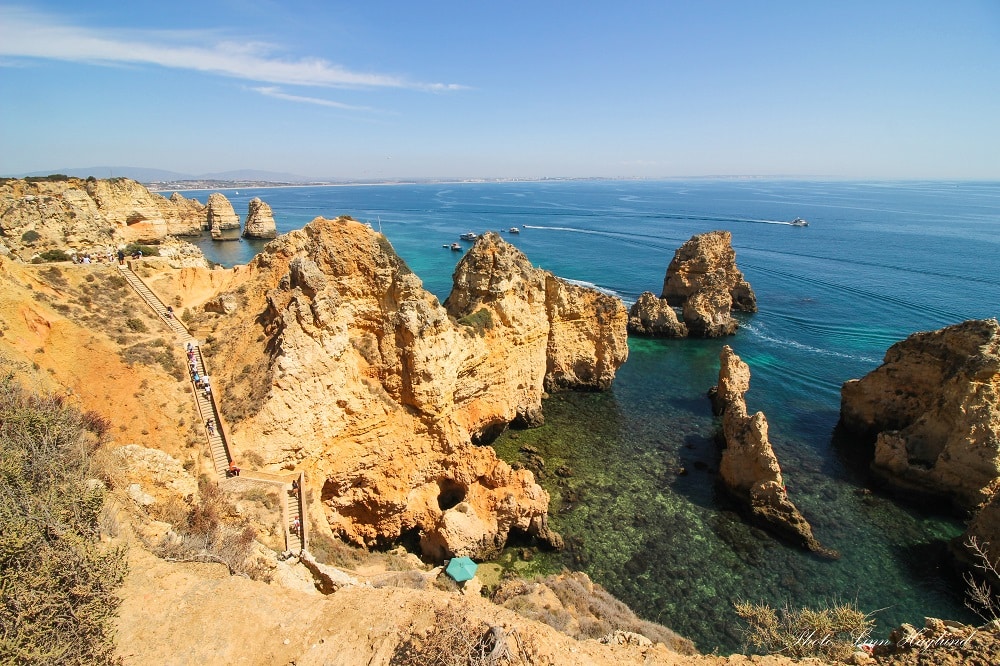
It takes about 30 minutes to walk from Lagos old town to the site and it is only 10 minutes to drive. Besides the viewing points and the stairs down to the waterfront, you can walk along the top of the cliffs or walk the boardwalk. Another way to see this impressive natural sight is to go on a kayak tour from Lagos where you will also discover other hidden caves and secluded beaches. Contributed by Linn of Amused by Algarve
Guimarães
The historic town of Guimarães is not only considered the birthplace of Portugal, but it was also the first capital city of the country. The town centre is listed as a UNESCO World Heritage Site.
It’s a great day trip from Porto and Braga and worth visiting. Not only is the old town quaint and beautiful, but it has a number of treasures.

Wander through the ancient streets and enjoy a glass of wine In Oliveira Square, overlooking the Monument of Salado and the Church of Our Lady of Oliveira. There are great restaurants in the square, like Buxa.
Visit the Castle of Guimarães, wandering the ramparts and imagining what this castle once was like. Then stop to visit the Palace of the Dukes of Braganza next door.
Go for a short walk to visit the stunning Church of Our Lady of Consolation and the Holy Steps. Wander in the beautiful garden on the edge of the historic town centre.

Then take the cable car up Penha Mountain for a real treat. Visit the Sanctuary of Penha and enjoy the views of Guimarães from above. Contributed by Sam from My Flying Leap.
Vincentine Coast Natural Park
The Vicentine Coast Natural Park is a stunning protected area in the south of Portugal. It’s a must-explore place in the country for those who love unspoiled nature and the outdoors. The area is considered one of the best-preserved coastlines in Europe. This beautiful park stretches for 150 km from north to south along the Atlantic coast.
The scenery in the park is spectacular; rugged cliffs, sandy beaches, picturesque bays, dramatic lookout points, natural caves, and charming fishermen villages. The highlights of Costa Vicentina include Cape St.Vincent, Carrapateira Beach, Praia da Bordeira, Ilha do Pessegueiro, and Cabo Sardão. The diverse wildlife of Costa Vicentina is another reason to visit the park. Dolphins, otters, falcons, storks, and eagles are just some of the most notable inhabitants.
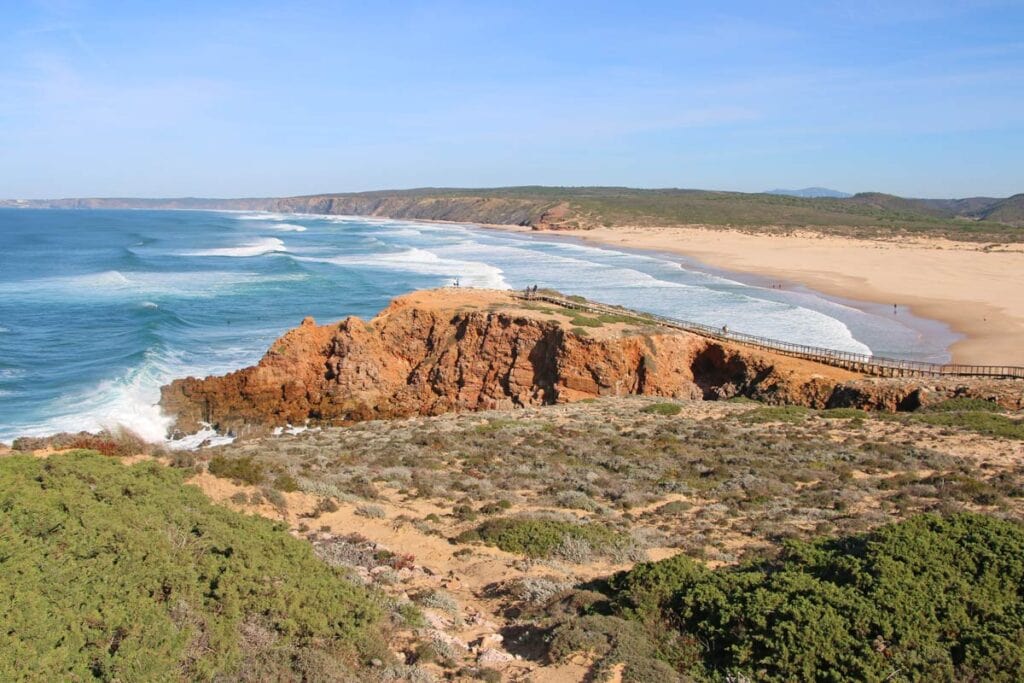
Hiking or cycling are the best ways to discover the beauty and tranquillity of the Costa Vicentina Natural Park. There are several hiking and cycling trails inside the park. The most famous is the Fisherman’s Trail, a multi-day route that goes along the coast from the small town of Porto Covo in Alentejo to Lagos in the Algarve. The total distance of the trail is 230 km. The trail was named one of the most beautiful coastal routes in the world.

Spring is the best time for visiting Costa Vicentina when the cliffs are covered in wildflowers and storks come to the area for nesting. Costa Vicentina is the only place in Europe where storks build their nests on the edge of the high cliffs. Alya from Stingy Nomads
Madeira
One of the most unique Portuguese islands to visit, is Madeira, just off the coast of Africa. This volcanic island is known for its incredible landscapes, local delicacies such as Madeira wine, and its year-round spring-like weather.
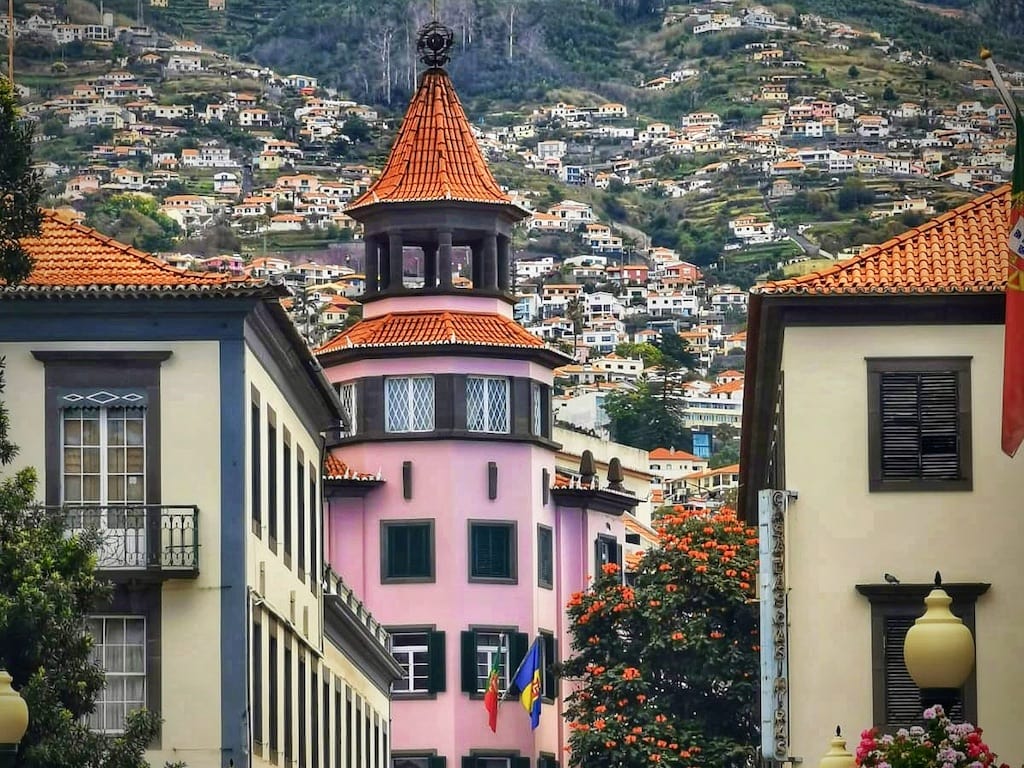
There are plenty of adventurous things to do in Madeira including mountain biking, whale watching, canyoning and hiking the Levada trails. The levadas are unique to the island and date back to the 16th century. They are a network of 200 complex man-made water channels that were created to irrigate the mountain slopes and carry water long distances to the island’s famous banana groves, vineyards, and tropical gardens. Nowadays the levadas are used as hiking trails and allow trekkers to reach the most remote spots on the island which aren’t accessible by road.
Other must-dos in Madeira include exploring Funchal (the capital). You can try the famous Madeiran chocolate at UauCacau, visit the botanical gardens, take in the cable car views, and even do a toboggan ride in a wicker sled! Contributed by Roshni from TheWanderlustWithin.com
Pinhao
Whether by train, car, or riverboat, Pinhao is a small town along the river you should definitely fit into your itinerary when you visit the Douro Valley. The town of Pinhao is quaint and full of charm and the surrounding landscape is breathtaking.
While in town you can go on a 2-hour river cruise which includes a historical background of the area or take the train to nearby towns like Peso da Régua for the day or even for just a meal.
For dinner, make sure you book reservations in advance. The town is very small and the good restaurants get filled up.

The highlight of our stay was visiting the wineries. Quinta da Roeda is located about a 15-minute walk from town and provides an absolutely amazing view of the Douro landscape. A tour can be arranged but we just looked around the visitor’s shop and ordered a cheese board with port tonic. We went in the spring and the bees were buzzing around the blooming flowers hanging from the lattices over the area providing shade.
We also visited Quita do Bomfim. Where they allowed us to taste several wines before deciding which ones to take home with us. Contributed by Dan Bagby – HoneymoonAlways.com
Bom Jesus
The Sanctuary of Bom Jesus do Monte is a Portuguese Catholic shrine in Tenões, outside the city of Braga, in northern Portugal. This pilgrimage site is over 600 years old and was declared a UNESCO World Heritage Site. It’s a Christian pilgrimage site and one of Europe’s Sacred Mountains.
From the 14th century onwards pilgrims were encouraged to make the ascent to the Bom Jesus do Monte Basilica at the top of the hill on their knees to praise and pray to God.

A plain neoclassical church stands on top of a wooded hill that is reached by the superb zig-zagging Baroque staircase, done in granite with a white façade The 577 steps, and 17 landings reach upwards from the bottom of the hill to the Basilica at the top.
The first funicular to be built in the Iberian Peninsula, the water balance Bom Jesus funicular was built in 1882 and is handy for those who cannot climb the stairs. The wooden carriages have been beautifully restored and the ride upwards is incredibly beautiful.
The summit of the hill is now a park with numerous caves, chapels, fountains, grottoes, lakes, lookout points and several hotels. There are walking and hiking trails into the surrounding hills.
Douro River Cruise
Exploring Portugal on a Douro River Cruise is one of the most unique and incredible experiences you can have. As your boat sails along the river, you’ll be able to take in lush vineyards, picturesque countryside, and quaint fishing villages that time seems to have forgotten. You’ll also get to learn about traditional Portuguese culture, sample some of the region’s best wines, and enjoy the delicious regional fare.

The Douro River offers a wide range of activities for travellers, so whatever your interests are there will be something for you to do. Explore ancient cities like Porto, where you can sit and watch the sunset over the river before indulging in some of the city’s famous port wine. Or take a hike up through the rolling hills and vineyards, or explore some of the region’s many historical sites. You could even spend a day fishing for trout or other river fish and sample your catch that evening.
No matter what you choose to do on your Douro River Cruise, you’re sure to have an unforgettable experience. Contributed by Melodie of Travel Must Do’s.
Aljezur and Sagres
A must-visit in the Algarve, Portugal is Aljezur, in the far west. A small town with a small population, this quaint town is often overlooked for the more popular places in the Algarve such as Lagos, Portimão, or Albufeira.
Founded in the 10th century by the Berbers and held by the Moors for 5 centuries, Aljezur is great to visit as it is not over-run with tourists, has beautiful, architecturally pleasing buildings, and narrow streets and square in which to enjoy the Algarvian sunshine. Visit the small ruined castle to look over the valley, once part of the river, or stop on one of the squares for a café and pastel de nata.
Close to Aljezur is the surfer paradise of Arrifana, a cove surrounded by high cliffs. Book yourself into the O Paulo restaurant and watch the sun go down.
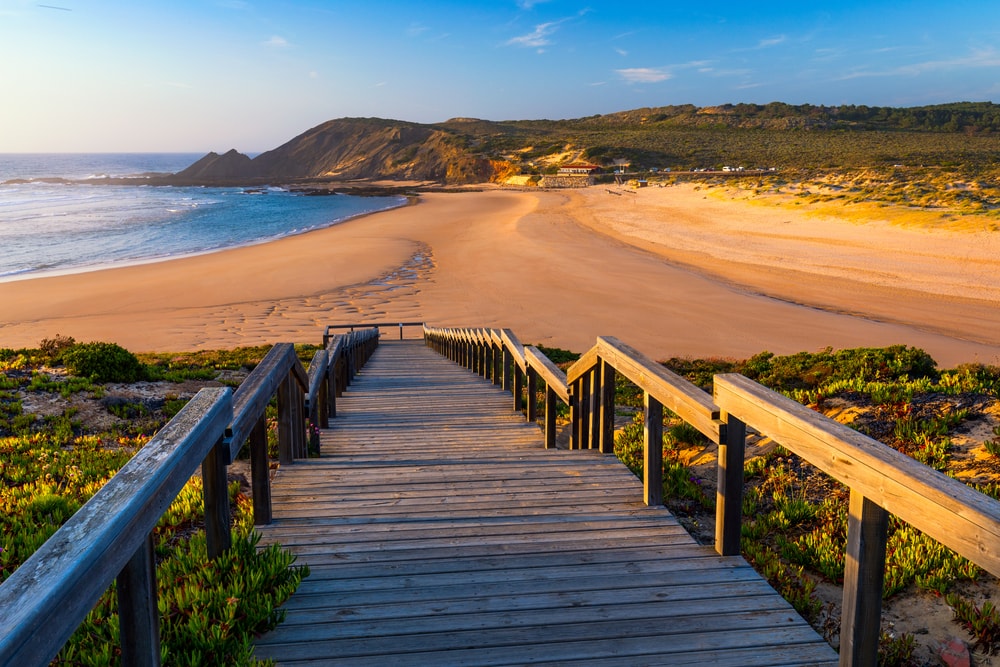
Within an hour’s drive is Sagres, with its stunning fort, sandy beaches on either side and beautiful coastline of amazing cliffs. You can drive down in the morning, visit the fort and then have lunch overlooking the small harbour at A Tasca Restaurant.
If you want beautiful coastlines, sandy beaches, some history, traditional Portuguese dishes and a quieter affair than the rest of the Algarve, make sure you put Aljezur and Sagres on your list for exploring Portugal. Contributed by Cath – Travel Around Ireland
Évora
Évora, in the Alentejo region of Portugal, is a town that is historically important. With its well-preserved old town, partly encased in medieval walls, and with historical and architecturally important buildings, it is no wonder the town of Évora is a UNESCO World Heritage Site.
Évora is located just one and a half hours drive east of Lisbon, so can be visited as a day trip from Lisbon if you don’t want to stay locally.
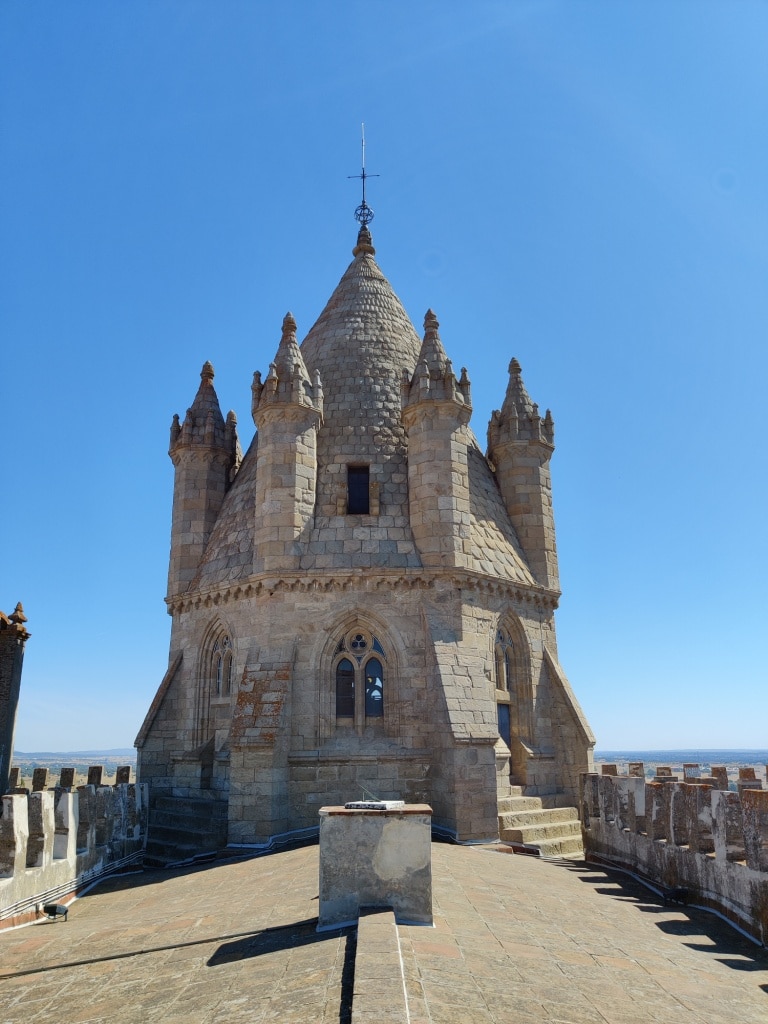
Things to do in Évora include visiting the Cathedral. As well as being beautiful, it offers visitors the chance to take in the views across the city from its rooftop.
Another great thing to see in Évora is its Roman Temple, believed to have been built in the first century AD. It was built in the main square at the time and although it is partly ruined, you can still get a feel for what it must have looked like at the time of the Romans.

The town also has an aqueduct and close to the town is the Cromeleque dos Almendres, a megalithic complex with an impressive standing stone circle that is older than Stonehenge.
One thing to note about Évora is that it gets hot during the summer months. It has recorded some of the highest summer temperatures in Portugal due to its central location within the country. But if you visit outside of the hot months, you are sure to enjoy Évora and its history. Contributed by Cath – Moving to Portugal
Quinta da Regaleira
On your journey exploring Portugal, one place not to miss is Quinta da Regaleira. It’s not only one of the most famous landmarks in Portugal but is also listed as UNESCO World Heritage Site.
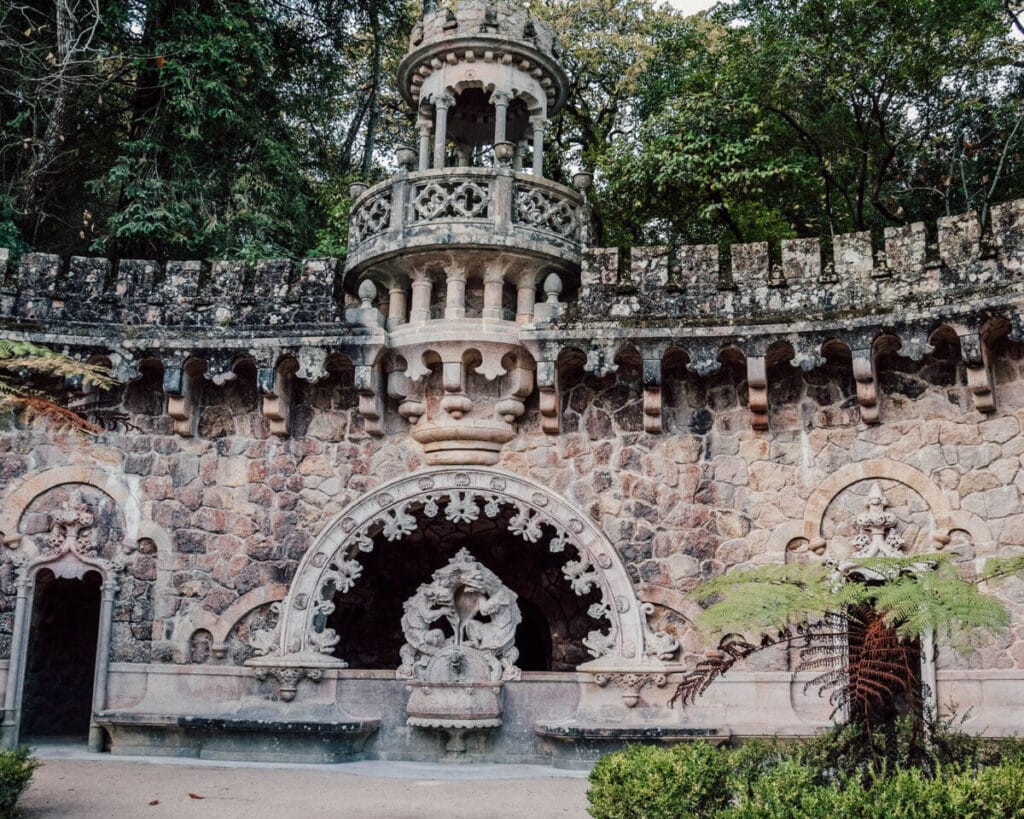
Quinta da Regaleira can be found in Sintra, a town not far from Lisbon. It’s basically a huge residence built in the 20th century including one grand house with five floors and enchanting gardens. However, what makes this place so special is the fact that it’s full of hidden tunnels, concealed symbolism and even features an initiation well!
Quinta da Regaleira is open all year long from 9:30 am to 8:00 pm (summer season) and 9:30 am to 6:00 pm (winter season). The entrance fee to see the grand house and the mysterious gardens is €6 for adults and €4 for children. You need to plan at least 1.5-2 hours to see everything. Contributed by Alina / World of Lina.
Lisbon
If you are thinking about travelling to Portugal, Lisbon must be at the top of your list of places to explore. Depending on where you are coming from you will most likely fly into Lisbon anyway, making it the perfect stop for the first few days of your trip.
Lisbon is the capital and largest city in Portugal with plenty to explore. You can start your tour of Lisbon off at one by riding the 28 Tram. Lisbon is a very hilly area, so even if says you only have a 20-minute walk you could be going straight uphill. Riding the tram helps save your feet and it is so much fun. Take the tram to the UNSECO sites Belem Tower or the Jeronimos Monastery. The iconic tower sits right on the Tagus River and it is so beautiful to view.
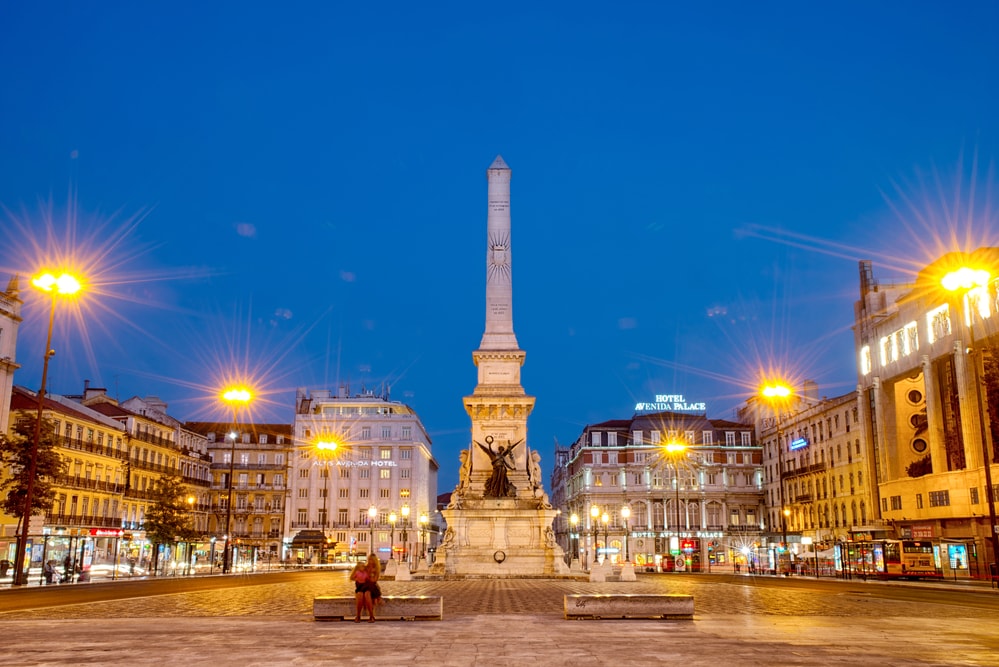
After that, you could check out one of the many rooftop restaurants in Libson with a view. The food and wine scene in Lisbon is very diverse, and you can find traditional Portuguese dishes, western food, and everything in between.
If you are thinking about staying to explore Lisbon for a few days the best neighbourhood to stay in is Barrio Alto. You will be in the heart of the old town with museums, boutique shopping, and the best nightlife in all of Lisbon. Exploring Lisbon never gets old, and you could stay for months and see have more to see. Contributed by Abbey of Tripsonabbeyroad.
Belem Tower Lisbon
5 miles west of downtown Lisbon lies the Belem neighbourhood where the famous Belem Tower (Torre de Belém) is situated. Belem Tower is a must-explore when in Portugal: it is one of the most beautiful and significant sights in the country! Belem Tower was built in 1515 originally as a fort to protect Lisbon from invaders coming from the Tagus River. Queues get big here so it’s best to arrive before 10 am when the Tower opens if you wish to go inside. Although you don’t have to go inside to admire its beauty – you can get some wonderful photos of the Tower and the bridge.
Located on the riverfront and surrounded by a lovely park, the location of Belem Tower is lovely – plus it is very easy to get to Belem from Lisbon – just hop on the number 15 tram!
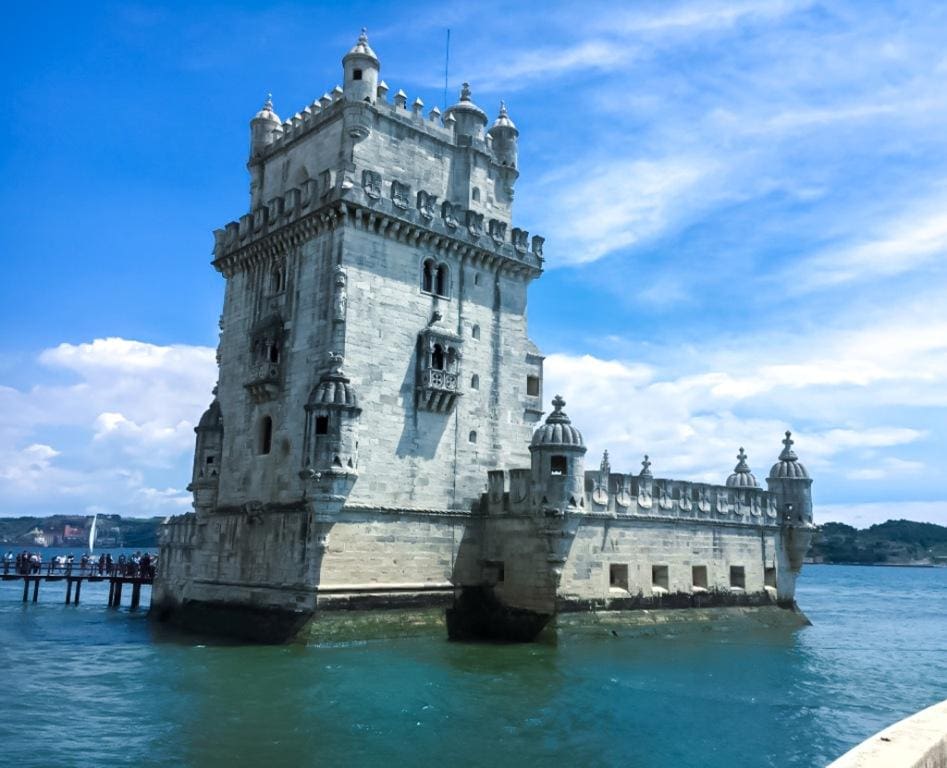
If you are looking for other historic and interesting sights in the Belem District, without a doubt head to the beautiful Jeronimos Monastery where the tomb of Vasco da Gama lies. Next to the Monastery you’ll find the famous cafeteria Pastéis de Belem – head in and get one of their delicious Pastéis de Nata pastries! Contributed by Catrina of 24HoursLayover.
Cascais
One of the most stunning areas in Portugal is the town of Cascais. The former fishing village is now a must-see spot for locals and tourists alike. Located a quick 40-minute train ride from Lisbon, Cascais has many cultural highlights and stunning natural wonders to explore.
Relax on one of three beaches and stop at one of the many cafes, or restaurants, or stroll the paradao along the Atlantic Ocean.
Excellent restaurants serving authentic Portuguese food are plentiful. As well as many types of upscale international cuisine including Brazilian, Japanese, Italian and more. Don’t miss the local delicious seafood that makes an appearance at almost every restaurant in town.
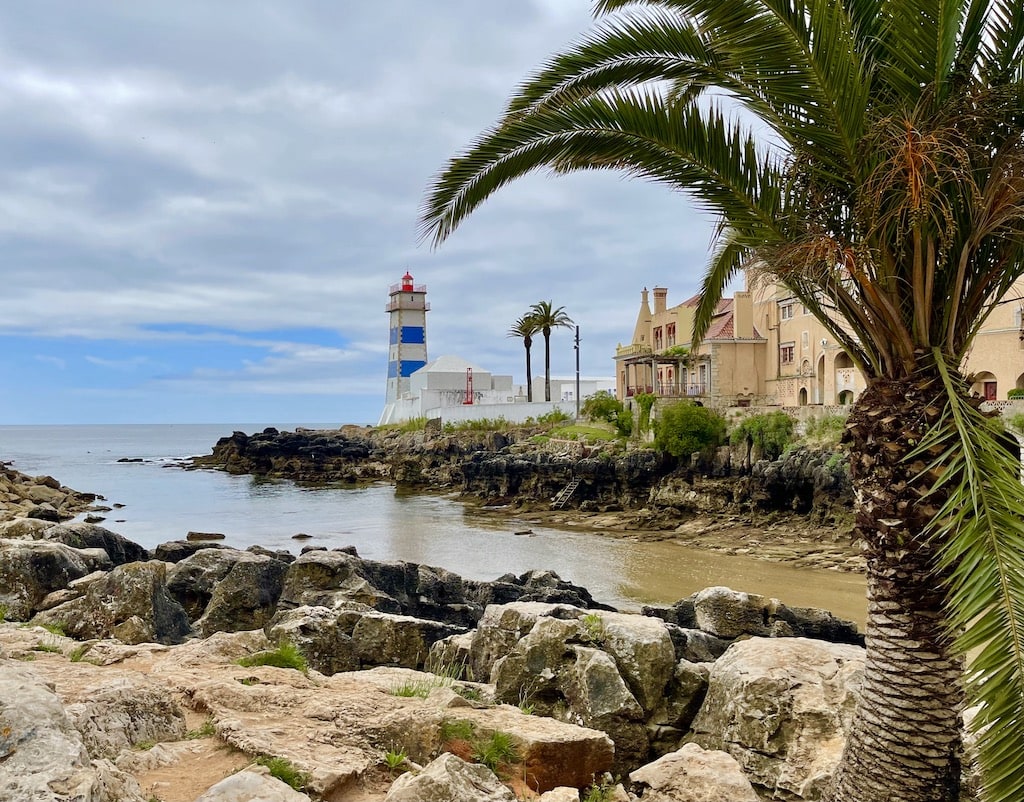
For those who like to enjoy nature head to the Sintra-Cascais Natural Park. The boardwalks through the Dune of Cresmina provide a perfect viewing spot to see the many species of plants, flowers, and birds that call this area home. Guincho Beach and Cabo da Inferno are other breathtaking highlights in the area.
Culture and history lovers will be happy to spend the day at the Casa da Histórias Paula Rego, the Cultural Center, Citadel, or the Santa Maria Light House Museum.
Visiting Cascais you will find is not just another day at the beach. Contributed by Sue of Food Travelist.
Ericeira
Ericeira is one of the best places to visit in Portugal. Not only is it a cute little fishing village that still retains its traditional charm, but it is also known to be the only World Surfing Reserve in Europe. It is definitely getting more and more visitors every year, so go now, before it gets overrun by tourism.

The best thing to do in Ericeira is, of course, surfing. It doesn’t matter if you are a beginner or a professional surfer, there is an option in Ericeira to soothe everyone’s level. Beginners can take a lesson at one of the excellent surf schools in town, like Ericeira surf house, while advanced-level surfers can go out and conquer the swell on their own at Coxos beach or Praia da Empa.
After all the surfing, take a yoga class or a massage at Sandhi House and have dinner at Praia de Ribeira d’Ilhas while watching the sunset. Contributed by Annelies | Travelers & Dreamers.
Faro
Not only is Faro the gateway to the Algarve, it also counts as one of the region’s cultural hotspots. Its main attraction is the Old Town, which is still encompassed by city walls that date back to the Roman era and were rebuilt in the 17th century.
The Arco da Vila is the most ornate of three city gates that give access to the Old Town. Follow the cobblestone streets lined with whitewashed houses and admire the squares dotted with orange trees. Climb the steps to the top of the Largo da Sé cathedral and visit the Faro Municipal Museum which is housed in the Convento de Nossa Senhora da Assunção.

Don’t miss the Nossa Senhora do Repouso chapel which is built into the Arco do Repouso city gate. Taking a seafood cataplana cooking lesson at the Tertúlia Algarvia restaurant is one of the best things to do in Faro for foodies. The main attraction in the new part of town is the Chapel of Bones located in the 18th-century Igreja do Carmo. Ria Formosa Natural Park is located right next to Faro town. Take a boat trip from the marina to explore the marshes, saltpans and freshwater lagoons while learning all about the unique fauna and flora. Contributed by Sarah of CosmopoliClan.
Douro Valley
Douro Valley has rightfully earned its spot as a prime UNESCO World Heritage Site location! Located just over one-hour drive outside of Porto, visiting Douro Valley as a day trip or weekend getaway may be the highlight of your Portugal vacation.
Terraced hillsides filled with luscious grapes paint scenery out of a storybook when arriving in this fairytale destination.
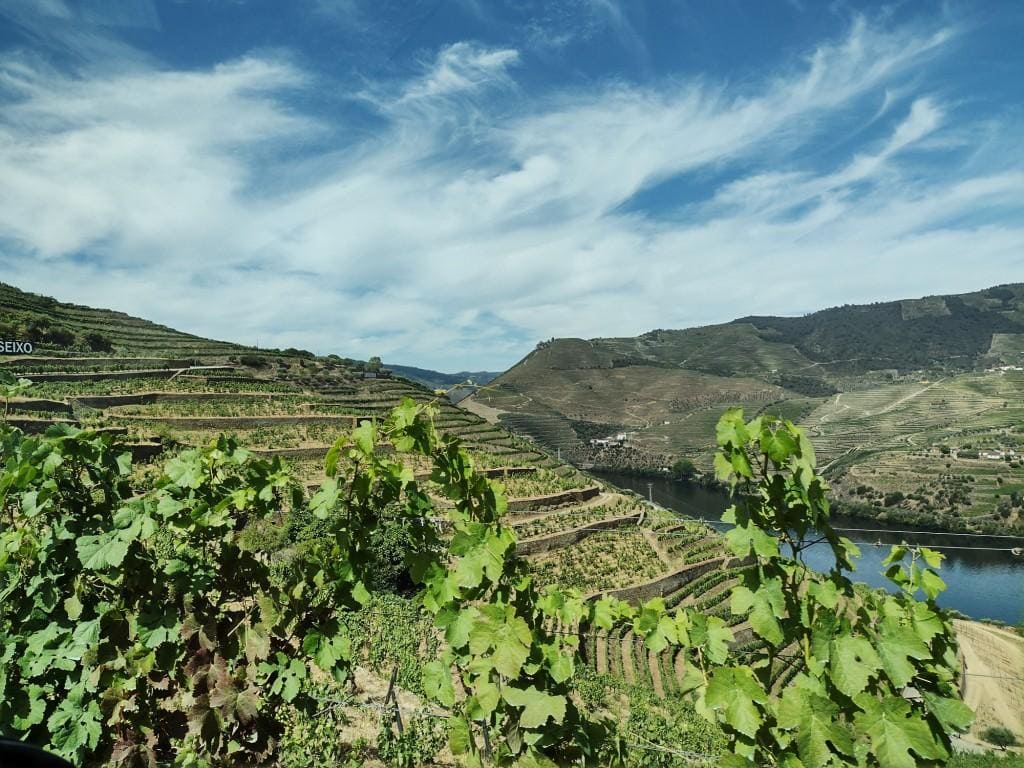
Top activities include boating down the Douro River, hiking, attending a wine tour, and exploring small towns. Outdoor lovers enjoy hiking trails woven throughout the wine estates and birdwatching. There are up to 170 bird species living in Douro Valley! For a more leisurely activity, hop in your rental car and drive Miradouro De Estrada Nacional 222’, voted as one of the world’s best drives.
If you are spending the night, consider relaxing at a Quinta or country estate. These family-like guest houses provide visitors with even more panoramic views from the comfort of a cosy stay. Contributed by Alyssa of An apple a plane.
Carvoeiro
Carvoeiro is a charming beach town not to miss when exploring the Algarve region of Portugal. The Algarve is known for its beautiful beaches and rugged limestone cliffs. The town is a little gem with awesome activities, plenty of places to stay, restaurants, cafes, and shops.
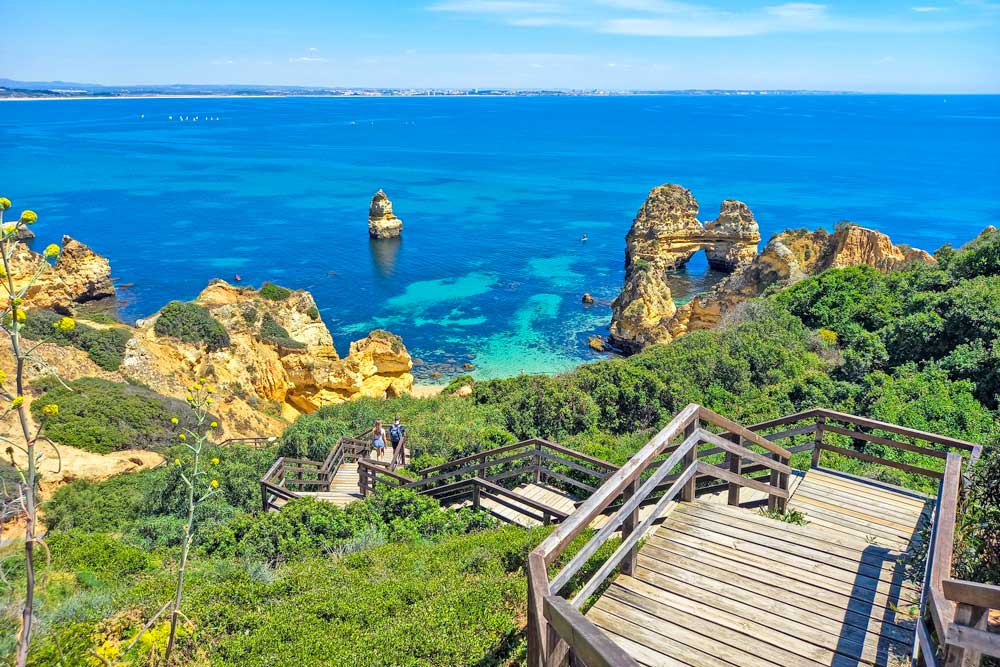
Enjoying the stunning beaches is the most popular thing to do in town. The main beach in town, Praia do Carvoeiro, is located in the centre of town and gets busy in season. The beaches Praia do Paraiso, Praia do Vale de Centianes, and Praia de Vale Covo is all located within walking distance from the town centre. Benagil cave is one of the most beautiful natural sights in Portugal and is located close to Carvoeiro. You can visit the famous cave with a kayak or a boat tour from Carvoeiro Beach.

There are several stunning hiking routes from the town including the beautiful Seven Hanging Valleys Trail and the Carvoeiro boardwalk. Boneca Bar, a small open-air bar between the cliffs overlooking the ocean, is a great place to come for a romantic spot for dinner. Contributed by Campbell from Thealgarvefamily.
Sao Miguel
Sao Miguel is the largest of the nine Portuguese islands that comprise the Azores. If you’re looking for a place to get away from it all and see some stunning scenery, this is the place to do it.
The size of the island – it’s just under 300 square miles – means it’s easy to see most things. The capital, Ponta Delgada, is a lovely place to visit, with its museums and botanical garden, and the harbour where you can book whale and dolphin watching tours.

The top thing to do, however, is to take a tour around the island and experience some of the wonderful volcanic landscape that the Azores is so famous for. There are lakes and craters, hot springs, and lava caves.
Not to be missed is the Caldeira das Setes Cicades in the west of the island. This iconic landmark is a seven-mile round volcanic crater housing two lakes: one green and one blue. There are several viewpoints where you can get out and wander around part of the upper rim.
A trip to the Vale das Furnas with its hot sulphur springs is also recommended. After seeing steamy, noisy springs bubbling up from between the rocks in the town, head to the Poca da Dona Beija thermal baths to experience them first-hand in the small heated hot pools. Contributed by Emma of Travelonatimebudget.
Nazare
Nazare might be the surf capital of Portugal, but you’ll love this beautiful city even if you’re not a surfer. The city has empty Atlantic beaches with gigantic waves, great seafood and a few historical attractions to explore.
For the best view in Nazare, ride the funicular up to the neighbourhood of Sitio, sitting on a cliff above Nazare beach. From here, you’ll have a panoramic view of the red tile roofs of the city and the ocean.
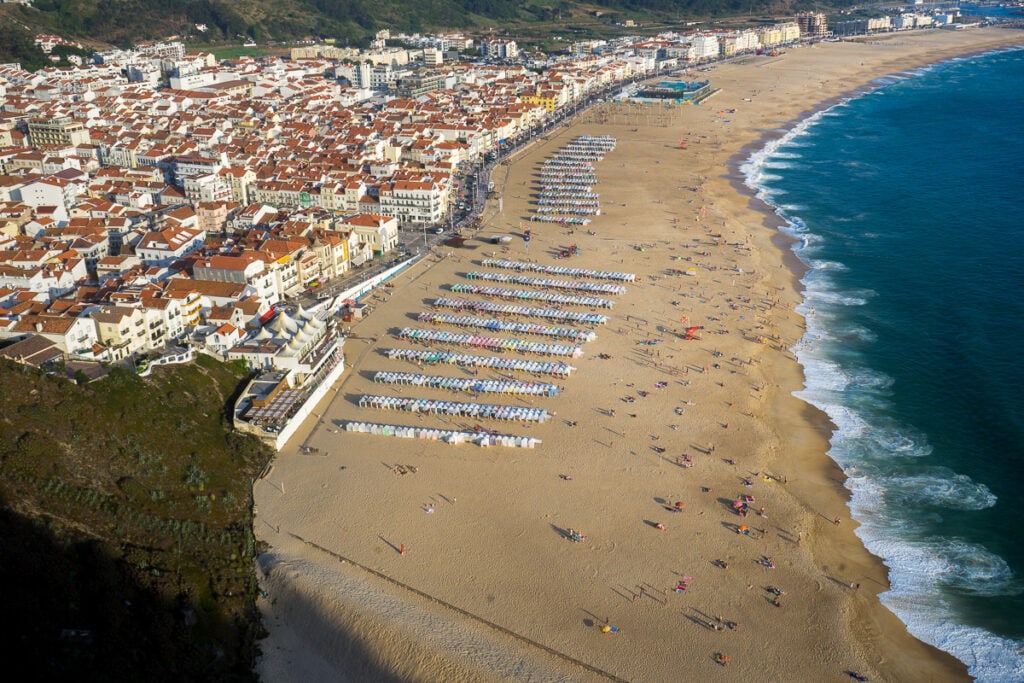
Also in Sitio, pay a visit to the beautiful Baroque church, Igreja Nossa Senhora da Nazaré. The church is believed to house a carving made by Joseph of Nazareth, and that’s how the city got its name.
To see the majestic Atlantic waves and the famous Praia do Norte beach, head to the Farol da Nazare where a small lighthouse sits above the top surfing spot in the country. A small but interesting surf museum inside the lighthouse is well worth a visit. If you’re in luck, the swell might be in, and you’ll be awestruck as the enormous waves slam into rocks below the lighthouse.
Find Casa Pires next to the church in Sitio for a fantastic seafood dinner. It doesn’t have a sign outside, so locals refer to it as the Place With No Name. The food here is so good that it’s understandable that they don’t need a name outside. Contributed by De Wet and Jin of Museumofwander.
Alfama
The Alfama district of Lisbon is one of the oldest areas of Portugal and was not damaged by the tremendous earthquake that levelled most of the city in the 1755 earthquake. In its original state, the district is made of narrow little roads and cobblestone streets with homes packed tightly into each other and spilling into small public squares.
The area is also known for the gorgeous viewing areas called Miradouro with beautiful ocean and river views along with panoramic vistas of the city from above. You’ll find all the main historic monuments here also to include the main cathedral or Se, the Castel de Sao Jorge or castle of St. Jorge, the Roman Theatre, the Museum of Fado along with all the traditional Fado performances and dinner clubs around the area.

This fascinating area is fun to explore by foot or take the infamous #28 trolley up the crooked streets all the way to the top and do an easier downhill walk to the bottom and main square of the city below.
You’ll love exploring the fabulous antique market, finding some delicious local eateries or browsing through the many cool shops and family-owned galleries in the area while just getting lost and experiencing this ancient and jumbled district that is hard to decipher but so fun to explore. Contributed by Noel of travelphotodiscovery.
Viana do Castelo
When I was hiking the Portuguese Camino, I came through many charming towns and villages. But none stole my heart like Viana do Castelo. This small city in the north has a beautiful old city centre. Its narrow streets weave from square to square, lined with colourful tiled houses and cosy tavernas. I recommended Casa Primavera for some Portuguese wine and local delicacies. You can easily spend a day or two wandering around here, discovering all the hidden gems.
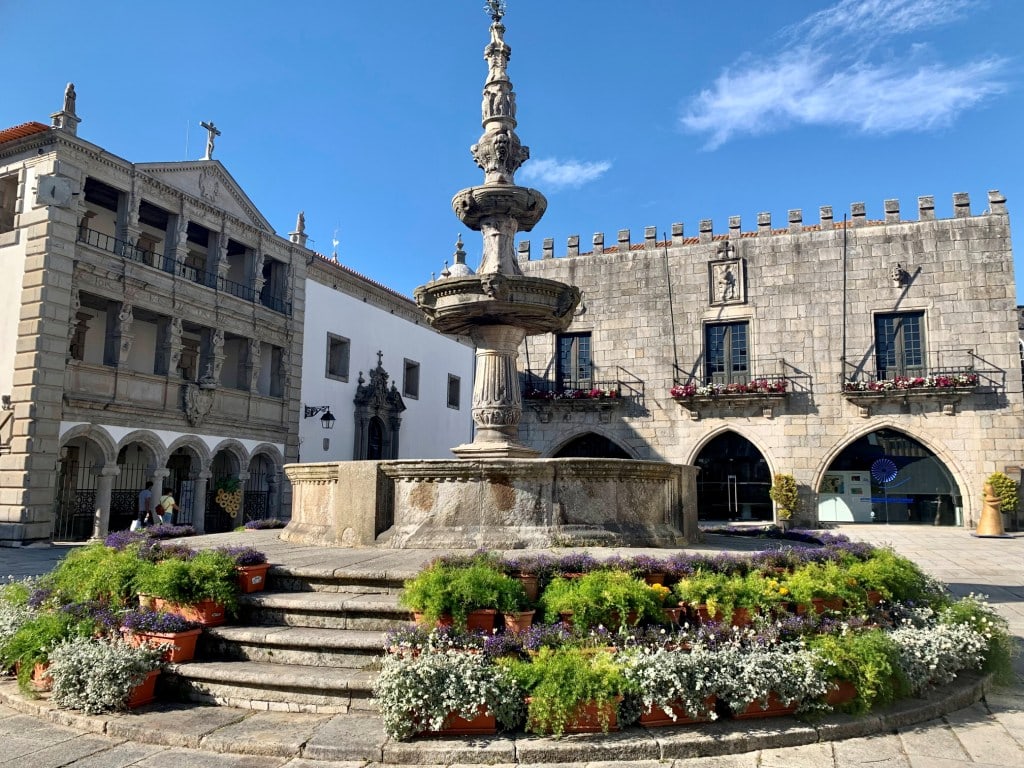
The literal highlight of Viana do Castelo is the Santuario de Santa Lucia. The 15th-century church sits up on the hill, offering a gorgeous view over the Portuguese coast. The easiest way to get there is by cable car.
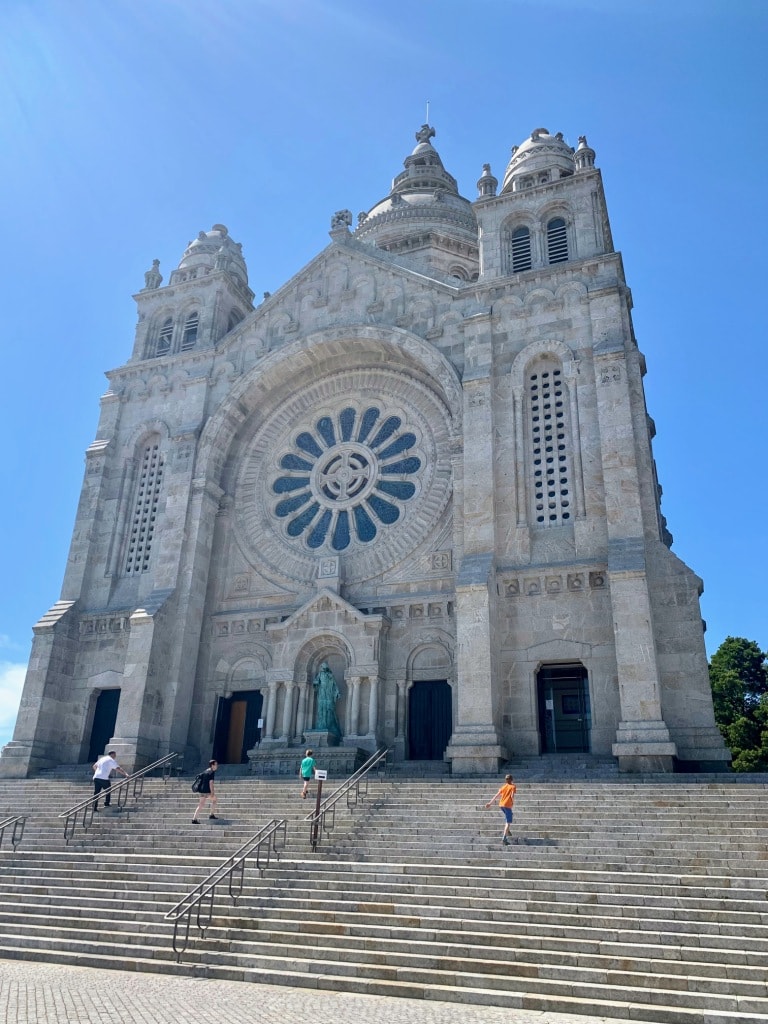
Viana do Castelo is a vibrant town, with regular street parties and concerts in the summer. For those who want to relax or catch some waves, the nearby Praia do Cabedelo beach is the place to be.
If you’re coming through Vaina do Castelo on a pilgrimage, I recommend staying at the Albergue de Peregrinos located inside the Carmelita church. Other tourists will enjoy their stay at the Casa Melo Alvim, a charming boutique hotel in the centre of town. Contributed by Sophie of Justheadingout.
Tavira
Tavira is a traditional fishing town in the eastern Algarve which combines breathtaking beaches with a unique mix of traditional architecture and Moorish influences. It earned its moniker as the “Venice of the Algarve” because of its beauty and the slow-flowing Gilao river running through the town centre. Walking along the cobbled streets, you will find traditionally tiled houses, decorative churches, restaurants and the bridge connecting the other side of the river.

The best place to visit there are the protected waterways and mudflats of the Parque Natural Da Ria Formosa which also has sandy beaches. You can take a ferry from the town centre and see different kinds of birds along the river on the way to Ria Formosa. Tavira is also a great base to explore the eastern Algarve. It’s a place where you can have an authentic Portuguese experience with modern facilities and services. Contributed by Angie at Goaroundphilippines.
Olhao
Olhao is a traditional fishing town situated in the heart of the Algarve. This is one of the must-visit towns in the Algarve due to its beautiful waterfront. The town is a fishing hub with a combination of eye-pleasing white-washed buildings. However, one thing that people love about Olhao is the fish market on the waterfront. It has its own charm, energy and quaintness. You must visit there to explore to find locally sourced honey, fruits and live chickens and a wide variety of freshly caught fish.
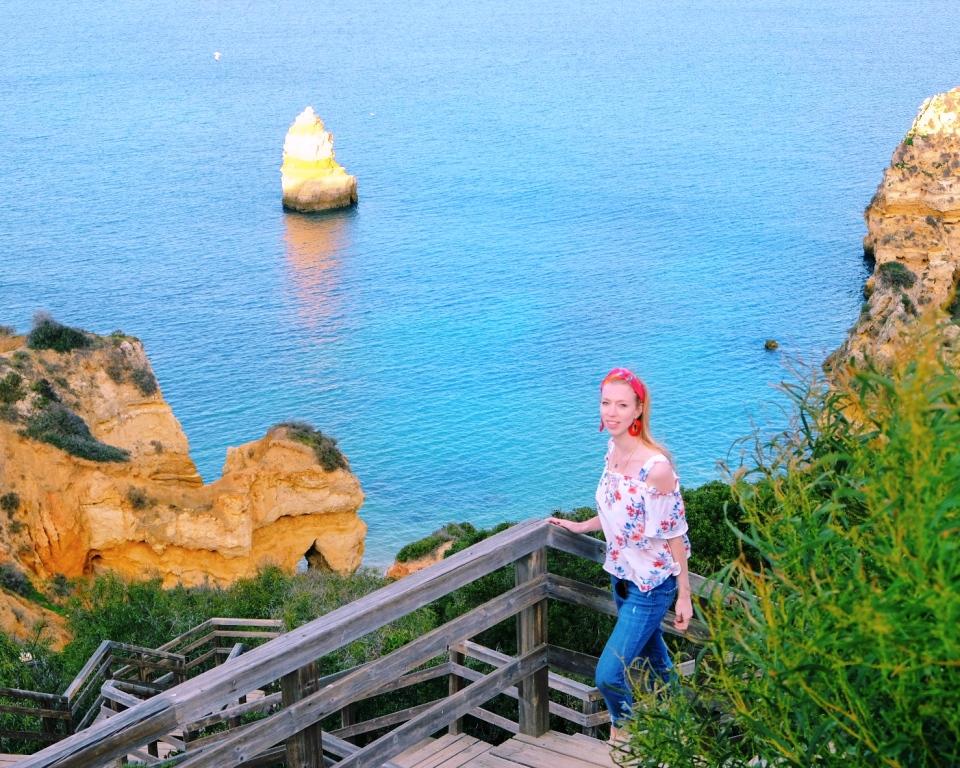
Get in the Moorish feel by visiting the old quarter. Witness the whitewashed buildings with box-chapped chimneys and flat roofs. You must explore the church of Nossa Senhora do Rosário which was built in the seventeenth century. Also, explore the biggest and most peaceful beaches of the Algarve from a short ferry ride from Olhao like Praia da Ilha da Culatra, and Praia da Armona. You must also experience bird watching around Ria Formosa- one of the biggest highlights of this town.
Enjoy traditional food like grilled sardines with potatoes and local seafood. If you are wondering where to stay in Algarve, consider Hotel real Marina for a wonderful experience.
There you have it your Portugal Travel Guide all the places you must visit in Portugal and what to see when you get there. I know I’m adding each and every one onto my Portuguese bucket list.
You might also enjoy reading:
Pros and cons of living in the Algarve
Pin it to save it

